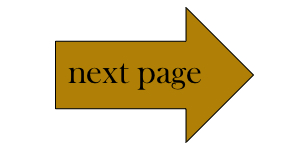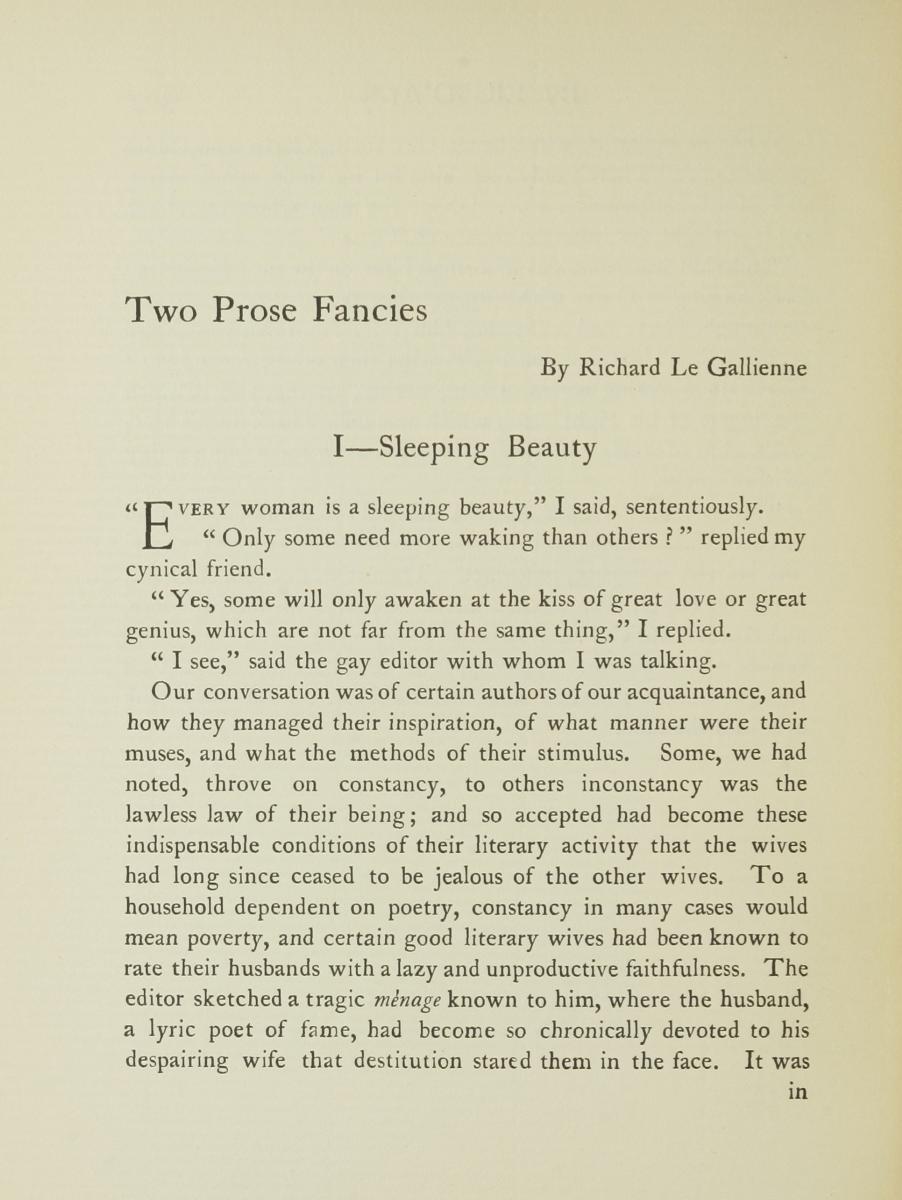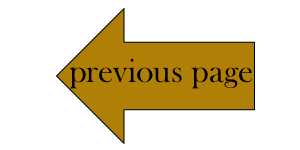The Yellow Book and the Power Dynamics Behind the Female Subject
Kaitlyn Fralick
Ryerson University
2321

|

|
|
Running from 1894 to 1897, The Yellow Book was a controversial avant-garde quarterly periodical that shook the world of print. Known for its vibrantly bewildering yellow binding, the magazine targeted itself towards a very niche demographic. Despite this, The Yellow Book has become the defining periodical of the 1890s (Hughes 849). Because of this, the studying of the text can provide integral information of the decade in question, but also answers questions of how that decade affected print culture. Featuring a multitude of late-Victorian figures, The Yellow Book published a wide variety of works such as essays, poems, and reproductions of paintings. Emerging in a time where theories of decadence and aestheticism were entering the lives of many, a question is raised surrounding how feminine beauty was regarded. Looking at two samples from the magazine, this exhibit in Situating the Yellow Book: Image, Text, Context, looks at the power dynamics at play behind the relationship of male creator and female subject and how The Yellow Book enters that discussion. The two examples come from the thirteenth and final volume of The Yellow Book (April 1897): an image, “Vanity” by D. Y. Cameron, and a text, “Sleeping Beauty” by Richard Le Gallienne, part of his “Two Prose Fancies” contribution to the issue. The former is a pen-and-ink etching of a female who is lavishly decorated in a dress with a low-neckline and bows in her hair. The latter is a prose piece situated as a conversation between two male figures discussing the value of women’s beauty. Both pieces raise questions concerning the ownership of feminine beauty, and the purpose behind how feminine beauty is presented in art and text. |
- The Author -
Richard Le Gallienne was a frequent contributor to The Yellow Book, appearing in nine of the thirteen volumes (Boyd). He wrote a reoccurring, multi-part series entitled "A Series of Prose Fancies,” later compiling all of these pieces into his own novel. Throughout the 1890s, Le Gallienne was a prominent author and critic (Boyd), appearing in multiple publications such as The Daily Chronicle and The Academy (Cohen). He had a strong connection with the publishing company The Bodley Head; Le Gallienne would plant book reviews for Bodley Head books in The Star, trying to promote a sense of need for Bodley Head books (Stetz 75). A common trend in much of Gallienne’s work is his frequent use of the female subject, one contemporary critic noted that he worshipped beauty (Brawley 47). This use is even prominently found in the titles of his work, such as his first, My Ladies’ Sonnets (Boyd), or even the selected piece for this project, “Sleeping Beauty.”
- The Artist –
- The Artist –
Sir D. Y. Cameron also had multiple publications in The Yellow Book. He was a Scottish artist, most prominently known for his landscape paintings of Scotland (Smith 7). Having trained at the Glasgow and Edinburgh Schools of Art (Willston), his work rose in popularity in the early 1890s (Smith 24). He was first associated with the “Glasgow Boys” (albeit younger), a group of male painters integral to the development of Scottish art (Smith 23). Concerning Cameron's oeuvre, this work was created mid-career. It showcases the second most common reoccurring theme in his work, that of the female subject; most of which were painted during the 1890s when Cameron produced many portraits and figure studies (Smith 33). Of his six contributions to The Yellow Book, three feature a female subject. Along with “Vanity,” are “The Butterflies” from the tenth volume and “A Girl’s Head” from the eighth, the former being very similar in style to “Vanity.”

Bodley Heads. No. I: Mr. Richard Le Gallienne
by Walter Sickert
|

Sir D. Y. Cameron
by Francis Dodd
|

|
As the period in which The Yellow Book emerged was a patriarchal society, it is surprising to note the lack of research done concerning the study of the fictional woman as a product that existed for males in late-nineteenth century magazines. The Victorian woman was destined for a specific natural role, that of motherhood or reproductive sexuality (Hughes 851). While the idea of the “New Woman Writer” was emerging at the time and went against this classical view of women’s role, often exploring ideas of active female desire (Hughes 851), it was not necessarily enough to fully challenge the passive female in works by males. At a time where effects of aestheticism were seen as destroying the masculine hetero-normal society, a research focus has been placed heavily on the cause and effects of this movement on males (Anderson 441). Despite The Yellow Book being progressive in the way of publishing multiple works created by females in the form of both art and text, the magazine was still often a male-dominated space, particularly in the first and final volumes (Hughes 850). While it was a space in which women participated, they had to petition for that right after the publication of the first as no women artists or authors existed in such (Hughes 853). Even after that first issue, the women characters within the magazine were often created by males, such as the chosen image (“Vanity” by D. Y. Cameron) and chosen text (“Sleeping Beauty” by Richard Le Gallienne) for the purpose of this exhibit.
It is my claim that a strong relationship exists between the male creator and male viewer in The Yellow Book, where the female subject, whether in art or text, is used to perpetrate the notion that women’s bodies are a product to be consumed by the male gaze. The male creator decides how the female subject is presented physically, such as in “Vanity,” where the subject is highly made up, and the male creator decides what the subject’s purpose is, such as in “Sleeping Beauty,” where she exists as a muse or an inspiration for the male. This characterization is what is presented to the reader who buys the magazine. In this sense, the female subjects are a commodity that can be created, sold, and bought in the form of an avant-garde periodical, with little (perhaps no) input by an actual female. The female subject is created by a male, for a male to gaze upon.
The Yellow Book and the Power Dynamics Behind the Female Subject
Kaitlyn Fralick
Ryerson University
2543

|
|
- Image - Sir David Young Cameron’s “Vanity,” is a pen-and-ink etching of a style consistent to many pieces contained within The Yellow Book due to its use of the female subject. With the concept of the “high art maiden” in mind, of which a female subject is characterized by her appearance and connection to her natural surrounding (Anderson 442), much can be drawn from this image. The female subject is lavishly made-up, with butterflies floating around her, meeting many requirements of the concept. However, the subject does not fully embody this description due to her beauty fitting more into the conventional beauty of the time, rather than that of sharp edges, lack of curves, or soulful, intelligent eyes (Anderson 442). One contemporary critic noted that while the majority of the artwork in the thirteenth issue of The Yellow Book was poorly done, this particular piece stood out positively from the rest (“Bad Art in the Yellow Book” BR5). The image seems to suggest the mainstream view of Victorian females, which could explain its positive review. Even the title suggests an emphasis on the vain (or negative) qualities associated with one when they focus on appearance. The body positioning of the subject, with her head tilted, nose in the air, gazing down into a handheld mirror, exemplifies this “vain” quality. While the quality of self-absorption was viewed negatively when seen in men, it was not viewed as being as serious of a problem in women, as they were seen to be naturally “feminine” (Bullen via Anderson 441). In multiple ways, the female subject is a passive subject, as she is only defined by her embodiment and consumption of beauty. The key fact is that female beauty is being depicted by Cameron, a male. The female subject is being depicted in a way that appeals to a male creator and for the male readership to view, while promoting ideals of the passive woman. |
|
- Text -
Richard Le Gallienne’s “Sleeping Beauty” was part of his “Prose Fancies” series published over various issues of The Yellow Book. The text begins as a conversation between two males in which they begin discussing women they have known. The piece continues to Le Gallienne arguing his opinions on beauty, often referring to women as the “muse” and “inspiration” of men (Le Gallienne 309). Similar to the reception of Cameron’s “Vanity,” Le Gallienne’s “Sleeping Beauty” was viewed positively, as standing out from a majority of poor pieces in the volume (“From Crowded Shelves” 590). Le Gallienne’s main argument is in some ways progressive of the time as he pushes against the sense of there only being one type of beauty and that “beauty is in the eyes of the beholder” (Le Gallienne 309). However, the piece cannot truly be deemed progressive as he states that a women’s beauty is “asleep” and must be “awakened” by a male: "All beauty was once asleep like that, even the very beauty your housemaid understands and perhaps exemplifies. It lay asleep awaiting the eye of the beholder, it lay asleep awaiting the kiss of genius ; and, just as one day nothing at all seemed beautiful, so some day all things will come to seem so, if the revelation be not already complete” (Le Gallienne 311). Essentially, this classifies the “sleeping” female as the passive, and the “awakening” male as the active. By choosing to conceptualize female beauty as not only an object, but also an object that only exists under a male’s terms, the female in question becomes reduced to that of a commodity to exist both because of and for the male. |

Sleeping Beauty
by Richard Le Gallienne
|
- Image + Text + Context -
It can be argued that the reason for both Cameron and Le Gallienne’s work to be viewed positively amongst others in a review could be due to the fact that their depictions of women do not stray too far from the traditional societal norm. In other words, neither piece threatens the power of males. In both Cameron’s “Vanity,” and Le Gallienne’s “Sleeping Beauty,” the female subject is being depicted in a way that appeals to a male creator for male readership to gaze upon. The female in the image is only classified by her beauty and vainness. In the text, the females are characterized by their waiting for someone, more specifically a male, to come along and see (or awaken) their beauty. In both instances, her beauty is owned by the male; the beauty is given (or suggested) by the artist and author, to be consumed by the viewer and reader, acting as the consumer.

|
A close-reading of Richard Le Gallienne’s “Sleeping Beauty” and D. Y. Cameron’s “Vanity” shows The Yellow Book’s place in the ongoing discussion of women’s roles in text and art. While the magazine was progressive in the sense that women authors’ and artists’ works were featured in multiple volumes, its run was still a primarily male-dominated space, particularly seen in the thirteenth volume as its contributors were primarily male (Hughes 851). This leads to the conclusion that males were in control of how women were viewed through The Yellow Book by merits of images, poems, and essays, mimicking the control of men in Victorian society. This is not to say that women were not pushing back against this and making new ground, as The Yellow Book did in some ways contribute towards the feminist movement as per the aforementioned inclusion of women’s work. This understanding can still be problematic as some critics make note that The Bodley Head and John Lane, the publisher of The Yellow Book, provided mixed messages concerning the goals behind the pieces they wanted to publish; while the genres in which their work published often went against the social order, John Lane found business advantage in going along with the social order at times, often he decided to publish work promoting old conventions that other work they published tried to destroy (Stetz 84). This can be scene in The Yellow Book, while the text was known for its publishing risqué material, many of the works featuring a female subject did not push boundaries, but instead perpetrated the current societal norm for a woman’s place in society.
To look at this issue from a twenty-first century point-of-view, it is hard to not compare that to the depictions of women displayed in contemporary magazines. The topic of the female body is still a prominent discussion in today’s society, whether it be in fiction or advertisements, there is still a question of who created that image and who that depiction is for. Was it created by a male? Is the purpose of the image for male viewership? The female body is still often treated as a commodity that can be created, sold, and bought through male-dominated spaces. Exemplified in both pieces, the female subject is being depicted in a way that appeals to a male creator and male readership to gaze upon; she is very much a product to be consumed.
The Yellow Book and the Power Dynamics Behind the Female Subject
Kaitlyn Fralick
Ryerson University
2545
Copyright Statement: Images in this online exhibit are either in the public domain or being used under fair dealing for the purpose of research and are provided solely for the purposes of research, private study, or education.

|
Anderson, Anne. “Life into Art and Art into Life: Visualizing the Aesthetic Woman or ‘High Art Maiden’ of the Victorian ‘Renaissance.’” Women’s History Review 10:3 (2006): 441-462. JSTOR. Web. 25 Oct. 2015.
“Bad Art in the Yellow Book.” Rev. of The Yellow Book 13. New York Times 17 July 1897: BR5. Ed. Dennis Denisoff and Lorraine Janzen Kooistra. The Yellow Nineties Online. Web. 22 Oct. 2015.
Brawley, Benjamin. “Richard Le Gallienne and the Tradition of Beauty.” The Sewanee Review Jan. 1918: 47-62. JSTOR. Web. 23 Oct. 2015.
Boyd, Jason. “Richard Le Gallienne (1866-1947).” Ed. Dennis Denisoff and Lorraine Janzen Kooistra. The Yellow Nineties Online. Ryerson University, 2013. Web. 12 Oct. 2015.
Cameron, D. Y. “Vanity.” The Yellow Book Apr. 1897: 7–9. The Yellow Nineties Online. Web. 12 Oct. 2015.
Cohen, Philip. “Le Gallienne, Richard Thomas (1866-1947).” C19: The Nineteenth Century Index. ProQuest, n.d. Web. 12 Oct. 2015.
Dodd, Francis. “Sir D. Y. Cameron.” 1923. Condrad R. Graeber Fine Art. Web. 18 Nov. 2015.
“From Crowded Shelves.” Rev. of The Yellow Book 13. Academy 5 June 1897: 590. Ed. Dennis Denisoff and Lorraine Janzen Kooistra. The Yellow
Nineties Online. Web. 22 Oct. 2015.
Hughes, Linda K. “Women Poets and Contested Spaces in The Yellow Book.” Studies in English Literature, 1500-1900 44.4 (2004): 849-872. JSTOR. Web. 24 Oct. 2015.
Le Gallienne, Richard. “Two Prose Fancies: I - Sleeping Beauty.” The Yellow Book Apr. 1897: 308–314. The Yellow Nineties Online. Web. 12 Oct. 2015.
Sickert, Walter. “Bodley Heads. No. I: Mr. Richard Le Gallienne.” The Yellow Book Jan. 1895: 80. The Yellow Nineties Online. Web. 5 Nov. 2015.
Smith, Bill. D. Y. Cameron: The Visions of the Hills. Edinburgh: Atelier Books. 1992. Print.
Stetz, Margaret Diane. “Sex, Lies, and Printed Cloth: Bookselling at the Bodley Head in the Eighteen-Nineties.” Victorian Studies 35.1 (1991): 71-86. JSTOR. Web. 26 Oct. 2015.
Syrett, Mabel. Front Cover of The Yellow Book 13. Apr. 1897. The Yellow Nineties Online. Ed. Dennis Denisoff and Lorraine Janzen Kooistra. Ryerson University. Web. 5 Nov. 2015.
Willsdon, Clare A. P. “Cameron, D. Y.” Grove Art Online. Oxford University Press, n.d. Web. 16 Oct. 2015.
Boyd, Jason. “Richard Le Gallienne (1866-1947).” Ed. Dennis Denisoff and Lorraine Janzen Kooistra. The Yellow Nineties Online. Ryerson University, 2013. Web. 12 Oct. 2015.
Cameron, D. Y. “Vanity.” The Yellow Book Apr. 1897: 7–9. The Yellow Nineties Online. Web. 12 Oct. 2015.
Cohen, Philip. “Le Gallienne, Richard Thomas (1866-1947).” C19: The Nineteenth Century Index. ProQuest, n.d. Web. 12 Oct. 2015.
Dodd, Francis. “Sir D. Y. Cameron.” 1923. Condrad R. Graeber Fine Art. Web. 18 Nov. 2015.
“From Crowded Shelves.” Rev. of The Yellow Book 13. Academy 5 June 1897: 590. Ed. Dennis Denisoff and Lorraine Janzen Kooistra. The Yellow
Nineties Online. Web. 22 Oct. 2015.
Hughes, Linda K. “Women Poets and Contested Spaces in The Yellow Book.” Studies in English Literature, 1500-1900 44.4 (2004): 849-872. JSTOR. Web. 24 Oct. 2015.
Le Gallienne, Richard. “Two Prose Fancies: I - Sleeping Beauty.” The Yellow Book Apr. 1897: 308–314. The Yellow Nineties Online. Web. 12 Oct. 2015.
Sickert, Walter. “Bodley Heads. No. I: Mr. Richard Le Gallienne.” The Yellow Book Jan. 1895: 80. The Yellow Nineties Online. Web. 5 Nov. 2015.
Smith, Bill. D. Y. Cameron: The Visions of the Hills. Edinburgh: Atelier Books. 1992. Print.
Stetz, Margaret Diane. “Sex, Lies, and Printed Cloth: Bookselling at the Bodley Head in the Eighteen-Nineties.” Victorian Studies 35.1 (1991): 71-86. JSTOR. Web. 26 Oct. 2015.
Syrett, Mabel. Front Cover of The Yellow Book 13. Apr. 1897. The Yellow Nineties Online. Ed. Dennis Denisoff and Lorraine Janzen Kooistra. Ryerson University. Web. 5 Nov. 2015.
Willsdon, Clare A. P. “Cameron, D. Y.” Grove Art Online. Oxford University Press, n.d. Web. 16 Oct. 2015.










